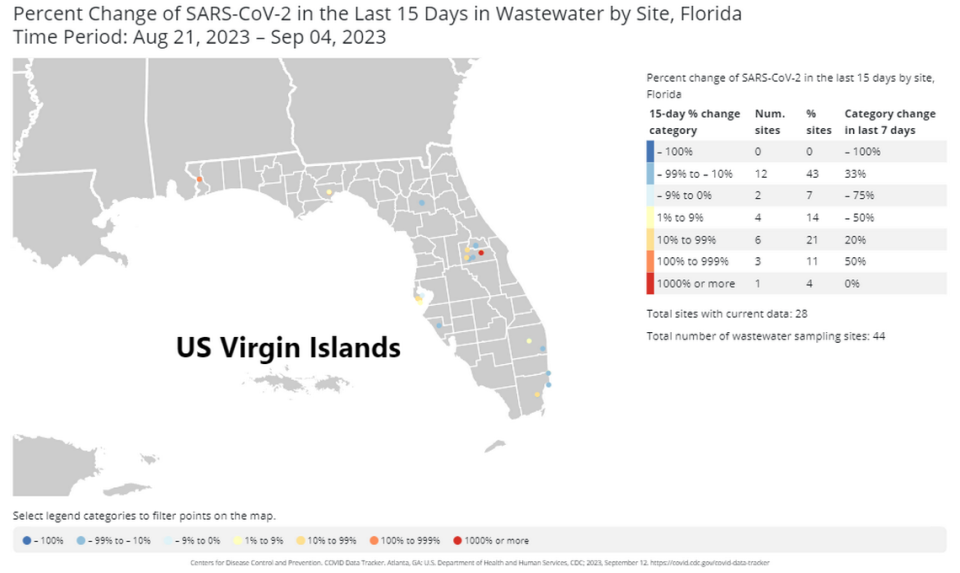Florida COVID hospitalizations are rising. A new COVID vaccine will be available soon
- Oops!Something went wrong.Please try again later.
A new COVID vaccine will soon be available to help fight a nationwide rise in cases and hospitalizations, including in Florida, which is recording some of the highest COVID hospitalizations in the country though they’re significantly lower than previous waves.
The U.S. Food and Drug Administration on Monday approved the new COVID vaccine formula made by Pfizer and Moderna to target the Omicron variant XBB.1.5, which was the dominant strain in the U.S. when the drug manufacturers began working on the new shots this summer for the 2023-2024 fall and winter season.
More variants have appeared since then, with the current dominant strain in the country being EG.5, also known as Eris, a descendant of the omicron variant. The FDA says the updated shots will provide good protection against the circulating variants.
“Vaccination remains critical to public health and continued protection against serious consequences of COVID-19, including hospitalization and death,” said Dr. Peter Marks, director of the FDA’s Center for Biologics Evaluation and Research in a statement. “The public can be assured that these updated vaccines have met the agency’s rigorous scientific standards for safety, effectiveness, and manufacturing quality. We very much encourage those who are eligible to consider getting vaccinated.”
READ NEXT: People are falling ill with COVID again. What to know about boosters, testing and masks
New COVID shots to be available soon
The FDA approved the new shots for people 12 and older and granted emergency use authorization for kids as young as 6 months to be given the new vaccines, which the agency expects will be updated annually like flu shots.
An advisory committee for the Centers for Disease Control and Prevention recommended Tuesday that everyone 6 months and older receive at least one dose of the new vaccine. CDC Director Dr. Mandy Cohen approved the recommendation, with the shots expected to roll out to retail pharmacies, doctors’ offices and other healthcare providers later this week.
Unlike other COVID vaccines and boosters, the federal government is not paying for the shots, though most insurance companies are expected to cover the vaccine cost. For people who don’t have health insurance, or whose health plans don’t cover the costs, free boosters will be available through community health centers, state health departments and pharmacies participating in the CDC’s Bridge Access Program, according to the CDC. Children eligible for the “Vaccines for Children” program can also get the vaccine from enrolled providers.
The vaccine rollout comes as COVID-19 hospitalizations and deaths in the country have ticked up again as the nation braces for the possibility of another tripledemic of flu, RSV and COVID, though it’s better prepared with COVID vaccines, influenza vaccines and new RSV vaccines and monoclonal antibodies.
COVID hospitalizations, deaths on the rise
The U.S. saw 18,871 new COVID hospital admissions the week ending Sept. 2, an increase of 8.7% from the prior week, according to CDC data. California saw the most new COVID admissions during this period, with 2,642. Florida saw the second highest number of new admissions, 2,536, an increase of 4.4% from the prior week, the data shows.
This is lower than the same time period last year, when Florida — a large state popular with seniors, an age group considered to be high risk for the disease — saw more than 2,600 hospitalized patients. And the state’s recent hospitalization numbers are “nearly 10 times lower than where we were at the worst of the pandemic,” said Jason Salemi, a University of South Florida epidemiologist who maintains a COVID-19 dashboard.
Deaths due to COVID have also increased in the state since May, with COVID deaths rising from 1.5% to 3.2% of all deaths in Florida, he said. COVID had previously accounted for more than 20% of deaths in Florida during the peak of the pandemic, he said.
Nationally, between July 2022 and June 2023, more than 300 people have died from COVID every day and “that is still like two to three bad flu seasons in one year. So, even though things are dramatically better than where we’ve been — those death numbers were three and four times higher in the year prior — we’re still having 300 people dying nationally from COVID-19,” said Salemi.
And it’s more difficult now to gauge the disease spread since COVID test sites are mostly gone, at-home test results don’t get reported and not everyone get sicks enough for hospitalization. But since everyone poops, wastewater data has become an effective tool to determine whether the disease is spreading more in a community
CDC data shows that COVID levels increased in Miami-Dade’s wastewater over the summer. In the past 15 days, COVID levels have stabilized or decreased, depending on which area the treatment plants serve in the county, according to the most recent wastewater data reported to the CDC.

The federal agency considers all of South Florida — Miami-Dade, Broward, Palm Beach and Monroe counties — to have a medium COVID risk level based on COVID hospitalization admission data. It’s encouraging people to stay up-to-date on vaccinations, quarantine if you test positive, and for people considered to be high risk for the disease to wear a high-quality mask or respirator, such as an N95 mask, in indoor public settings. It’s also encouraging people to mask up when indoors with people considered to be high-risk for the disease.

